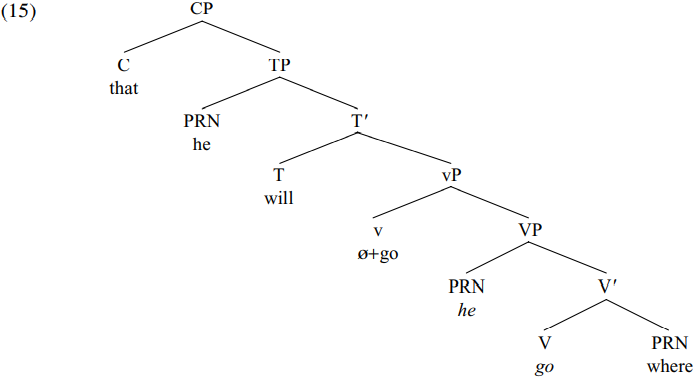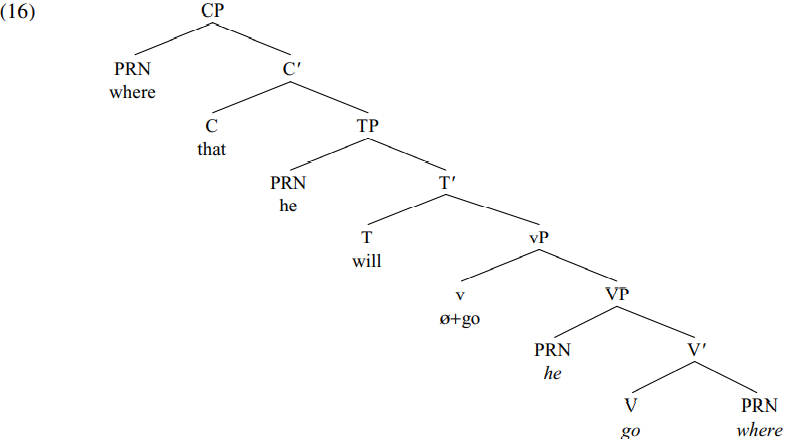
Wh-movement through spec-CP
 المؤلف:
Andrew Radford
المؤلف:
Andrew Radford
 المصدر:
Minimalist Syntax
المصدر:
Minimalist Syntax
 الجزء والصفحة:
388-10
الجزء والصفحة:
388-10
 2023-02-17
2023-02-17
 1836
1836
Wh-movement through spec-CP
The phase-based theory of syntax outlined above has far-reaching consequences for the operation of A-bar movement operations like wh-movement – as we can illustrate in relation to the following sentence:

The derivation of (13) proceeds as follows. The unaccusative verb go is merged with its GOAL argument (the locative adverbial pronoun where) to form the V-bar go where, which in turn is merged with its THEME argument he to form the VP he go where. This in turn is merged with a null affixal light verb which triggers raising of the verb go to v from its original (italicized) position in V, so forming:

Since vP is intransitive (by virtue of the fact that the light verb has no external argument), vP is not a phase, and Transfer cannot apply at this point. The syntactic computation therefore continues, with [T will] merging with the vP in (14). Will agrees with (and assigns nominative case to) he, and the [EPP] feature of will triggers raising of he from its original position (italicized below) in spec-VP to spec-TP. Merging the complementizer that with the resulting TP forms the CP shown in (15) below:

Since CP is a phase, its domain (i.e. its TP complement) will undergo transfer at this point. This means that neither TP nor any of the constituents of TP will subsequently be accessible to further syntactic operations – i.e. in effect, TP and its constituents are frozen in place once TP undergoes transfer.
However, this causes an obvious problem, since if all constituents of TP are frozen in place at this point, the wh-word where will be unable to move from the (sentence-final) VP-complement position it occupies in (15) to the (sentence-initial) main-clause CP-specifier position which it clearly needs to occupy in (13) Where is it thought that he will go? One way to overcome this problem is to assume that wh-movement applies in a successive-cyclic fashion, and that the complementizer that in structures like (15) has an [EPP] feature and a [WH] feature which together trigger movement of the closest wh-expression (= where) to become the specifier of the complement-clause CP headed by that before where subsequently moves on to become the specifier of the main clause C constituent containing the inverted auxiliary is. If this is so, at the stage of derivation represented in (15) above, where will move from the italicized position shown in (16) below to become the specifier of that:

At this point (once all the operations which apply on the CP-cycle have applied) the domain of C (i.e. its TP complement) will undergo transfer in accordance with (7i), because CP is a phase: one consequence of this is that the italicized traces will be marked as receiving a null spellout in the phonological component.
After transfer of TP is completed, the syntactic computation continues. The CP in (16) is merged as the complement of the verb THINK, and the resulting VP is in turn merged as the complement of a participial light verb (ensuring that think is eventually spelled out as the passive participle thought), with the verb THINK (below shown as thought) raising to adjoin to the light verb. The resulting vP is in turn merged as the complement of [T BE], which has an [EPP] feature that is deleted by merger of expletive it in spec-TP (it in turn serving as a probe valuing the agreement features of BE). Merging the resulting TP with a null affixal C will trigger raising of BE from its original (italicized) position in T to C; since C also has a wh-attracting [EPP] feature, it will trigger movement of where from the italicized spec-CP position in the complement clause into spec-CP position in the main clause, so deriving the CP shown in simplified form in (17) below:

Since CP is a phase, its domain (= the main-clause TP) will undergo transfer by (7i) at this point, so that the italicized traces of is, thought and where will receive a null spellout in the phonological component. Subsequently, the constituents where and is+ø on the edge of the root CP undergo transfer by (7ii).
What our discussion here tells us is that just as A-movement applies in a successive-cyclic fashion (each time moving the relevant nominal into the next highest spec-TP position in the structure), so too (within a phase-based theory of syntax) A-bar movement operations like wh-movement must apply in a successive-cyclic fashion: this means that each time a new phase head is introduced into the structure, it will serve as a probe which attracts the closest wh-goal to move into its specifier position.
 الاكثر قراءة في Syntax
الاكثر قراءة في Syntax
 اخر الاخبار
اخر الاخبار
اخبار العتبة العباسية المقدسة


